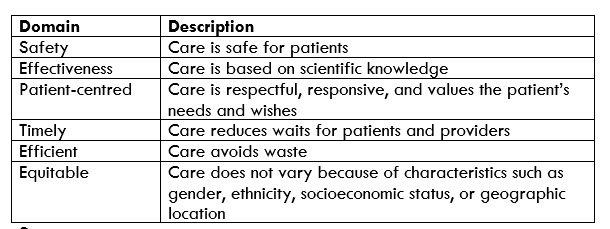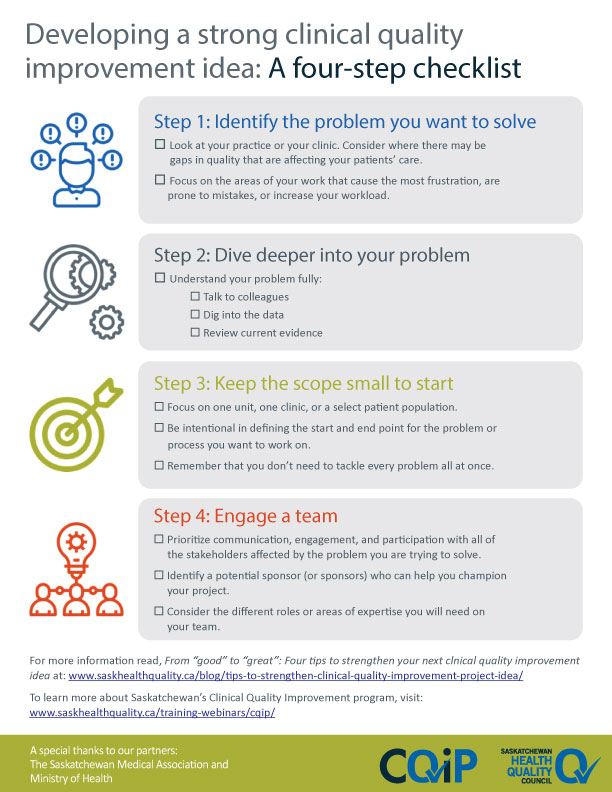* You don’t work in a clinical setting? No problem! The tips in this article are equally applicable to those doing improvement work in non-clinical areas too.
Have you ever wanted to start a quality improvement project at your workplace and didn’t know if your project idea was strong enough to catch steam? Or, maybe you are planning to apply to Saskatchewan’s Clinical Quality Improvement Program (CQIP) and would like some help with developing your clinical QI project idea. If either of these scenarios is familiar, then the advice that follows is for you.
To support your quest to develop a top-notch QI project idea, we invited CQIP faculty, coaches, and alumni to share their tips on what it takes to bring a QI project from “good” to “great.” Here’s what they had to say:
Tip 1: Identify the problem you want to solve

In its publication, Crossing the Quality Chasm, the Institute of Medicine identified six domains of health care quality (see table below). Take a close look at your practice or your clinic, and consider where there may be gaps in quality that are affecting your patients’ care.

With the quality domains in mind, ask: What issues frustrate me most? Where do we have processes or procedures where errors tend to occur? Where are there communication gaps, unnecessary delays, or rework?
These questions may generate a long list of problems you could tackle. Don’t let yourself get overwhelmed! Instead, focus on the areas of your work that cause the most frustration, are prone to mistakes, or increase your workload. What is the biggest problem we face? What problem would our team be most prepared to address right now? Where there’s a will, there’s a way!
Tip 2: Dive deeper into your problem

People who are eager to make a change are often full of good ideas. As humans, we are simply hard-wired to find solutions to our problems. The challenge is, sometimes the solutions we come up with may not necessarily address the problem we’re actually trying to solve.
Now you have identified the problem you are trying to solve, the next step — and the key to solving this problem — is to understand your problem fully. Doing that means asking some tough questions, such as:
- How do you know that this problem really is a problem?
- Do others feel the same way as you do about this problem?
- What is the extent of the problem? At what times and under what conditions is this issue a problem?
Although it’s natural to want to jump straight to the problem-solving stage, taking the time to unpack these questions can be invaluable. As a few ways to get started, CQIP faculty recommend:
- Talking to colleagues. One person wanting something to change doesn’t always indicate there’s a problem. But, if you and others you work with share the same frustration, this could highlight an opportunity for improvement. Be sure to connect with people within your department (and elsewhere) who are affected by this problem, and also reach out to those who may have a role in addressing the problem. These initial conversations are a great way to engage stakeholders early on in your QI project idea!
- Digging into the data. What data exists, or what information could you gather, to help you understand this problem? Start now to gather this “baseline” data. Data is foundational in highlighting the presence and extent of a problem, and will also be critical at later stages of your QI project in demonstrating whether the changes your team is testing are resulting in improvement.
- Review current evidence. There are a number of resources that can point you toward best practices to guide clinical decision-making or benchmarks to assess performance. For example, Choosing Wisely Canada has developed a number of recommendations, evidence-based tools, and patient resources to support appropriate clinical decision-making. As well, the Canadian Institute for Health Information produces a wide range of reports that inform discussions on how to improve care quality and enhance patient safety.
Tip 3: Keep the scope small to start

After seeing the number and breadth of problems that exist, it can be tempting to want to try to fix everything all at once. With that, it’s probably no surprise that a common QI mistake people make is in scoping their project too large.
Rather than trying to tackle every problem at once, the QI strategy is to start out small. This allows you to work on a problem where you can meaningfully enact change. Focus on one unit, or one clinic, or a select patient population. Be intentional in defining the start and endpoint for the problem or process you want to work on.
While you want to focus on problems that will have the greatest opportunity to impact patients and the broader health system, remember that you don’t need to tackle every problem all at once. Decide what small piece of that larger puzzle you could tackle first to result in the biggest ‘bang for your QI buck’.
By starting small and demonstrating reliable success with a change idea in a small setting, you can always look to scale those ideas up later.
Tip 4: Engage a team

QI is definitely not a ‘one-man show’! A key factor in the success of any quality improvement project is team engagement. Prioritize communication, engagement, and participation with all of the stakeholders affected by the problem you are trying to solve and the QI process.
Start by identifying a potential sponsor (or sponsors) who can help you champion your project. A project sponsor serves as the critical link between senior leadership and the project team and should be in a position to provide resources and remove barriers on behalf of the team when needed.
As the team leader, you will also want to consider which different roles or areas of expertise you want represented on your team. Look at the problem you are aiming to address, and what specifically you are trying to achieve. You’ll want to include team members who are familiar with all of the different parts of the problem or process, including physicians, nurses, administrative staff, other healthcare staff, and patients to leverage their wisdom. Learn what is most important to them and encourage them to contribute ideas to tackle the problem at hand. Look for ways to help them embrace and begin to take ownership of the changes as your team’s improvement work moves forward.
The Institute for Healthcare Improvement shares some examples of who you should consider engaging on your team, which describes some of the considerations you’ll want to have in mind when forming your clinical QI team and offers some examples across different types of QI projects.
Examples of great clinical QI projects
Example 1: This project aimed to reduce the number of inappropriate emergent CT scans of the brain performed at Victoria Hospital by 50% by September 2018.
In this project, CQIP Cohort 2 participant Dr. Randall Friesen (Prince Albert) and his team initially identified the problem as being about the high demand for CT services (tip 1). However, in diving deeper (tip 2), the team learned that there was variation in physician ordering of CT scans and inconsistent use of the existing decision tools for emergent CT scans.
To keep things manageable, the team scoped this project to focus on a specific test (CT scans of the brain) and hospital site (tip 3). This made it easier to identify who to engage in the improvement process. Clinicians and staff from the emergency department and diagnostic imaging at Victoria Hospital helped the team develop an evidence-based checklist to support physician ordering and were involved in providing feedback to the team about the utility of that tool about that tool (tip 4).
Learn more about Dr. Friesen’s project.
Example 2: This project aimed to increase the number of HIV tests completed in North Battleford by 50% by November 2017.
This project, led by CQIP cohort 1 participant and family physician Dr. Erin Hamilton, sought to improve patients’ awareness of their HIV status and ensure HIV-positive patients were linked with appropriate and timely HIV treatment and primary care. The focus of this project emerged from provincial and local data indicating rising HIV rates in Saskatchewan (tip 1).
In a survey of local physicians, the team discovered there were several barriers that were preventing physicians from conducting routine HIV testing (tip 2). This finding emerged despite Saskatchewan HIV testing guidelines being in place that recommend offering a test to all patients between 13-70 who receive primary or emergency health care and do not know their HIV status.
The team involved a selection of physicians from family practice, emergency medicine, and general surgery in testing a number of change ideas (tip 4), all ultimately geared toward increasing the number of HIV tests conducted.
Learn more information about Dr. Hamilton’s project.
Tying it all together
The success of any quality improvement project is largely dependent on the work done upfront. Defining and understanding the problem, scoping the project, and engaging the right people are all critical steps that will set up the team to formulate and execute their change ideas.
The checklist below can help you develop your next clinical quality improvement idea. Click the image to download, or download it here.
Want to learn more?
If you are a Saskatchewan clinician (a physician or other health professional) working in a clinical setting who is interested in taking your QI learning to the next level, consider applying to the fourth cohort of the Clinical Quality Improvement Program (CQIP).
Participants in this applied learning program build knowledge and skills in the science of quality improvement. By leading a team in a local clinical improvement project, you also have the opportunity for hands-on practice in applying QI tools and methodology.
For more information about CQIP, email cqip@hqc.sk.ca. You can also register here to be added to the waitlist for future cohorts and be contacted when the next set of applications are open.
A special thanks to the following CQIP Cohort3 faculty members for contributing their ideas to this post: Dr. Chantal Ansell, Dr. Phillip Fourie, Dr. Gary Groot, Dr. Mofoloshade Onaolapo. And a special thanks to our program partners, the Saskatchewan Medical Association (SMA) and the Ministry of Health.
Related reading:
- Panel discussion: how CQIP changed the way I practice medicine
- QI program for SK clinicians accepting applications for next wave of training
- Reflections on QI learning from CQIP’s 2nd Cohort





